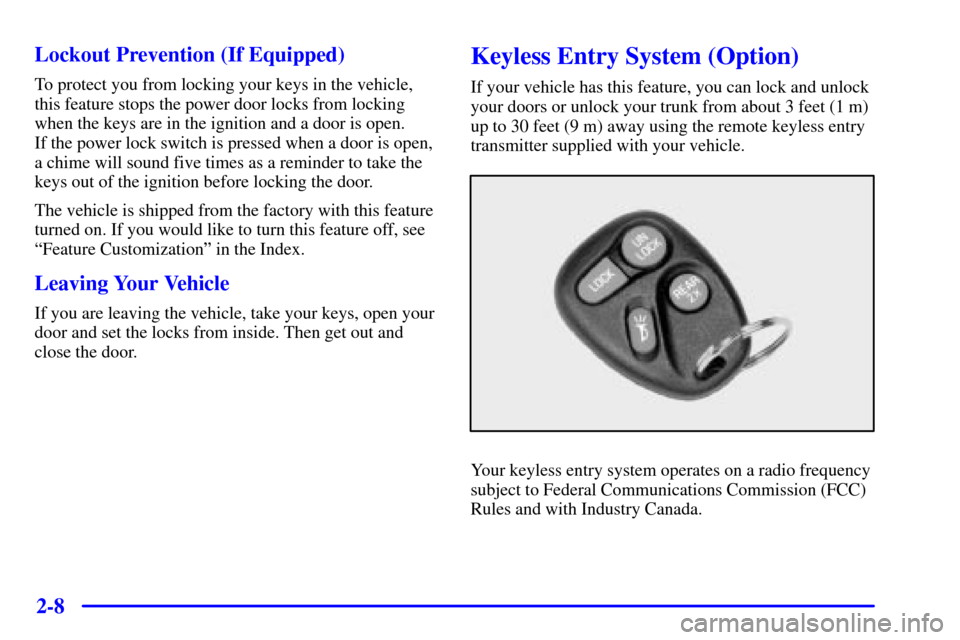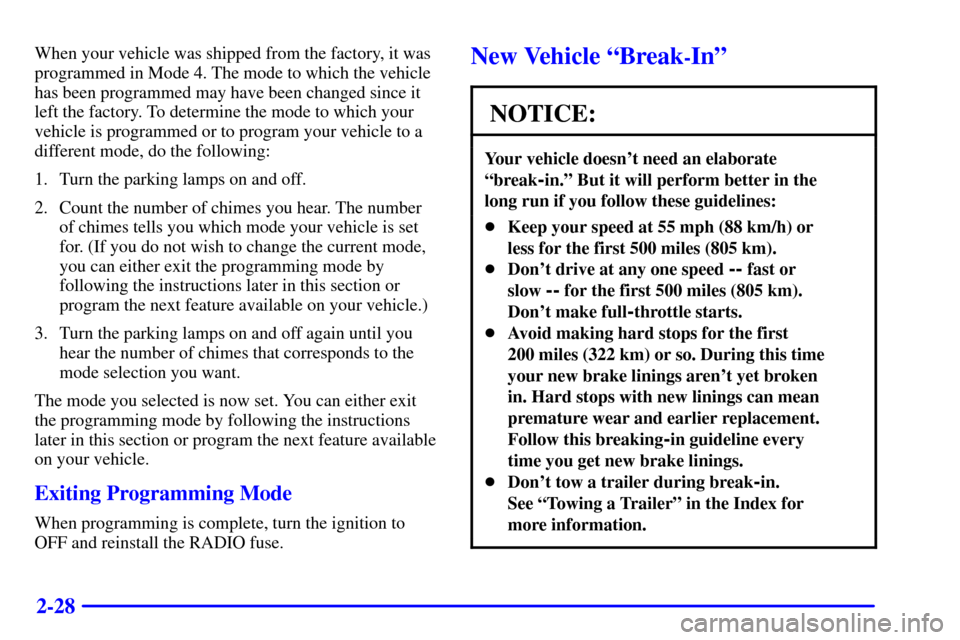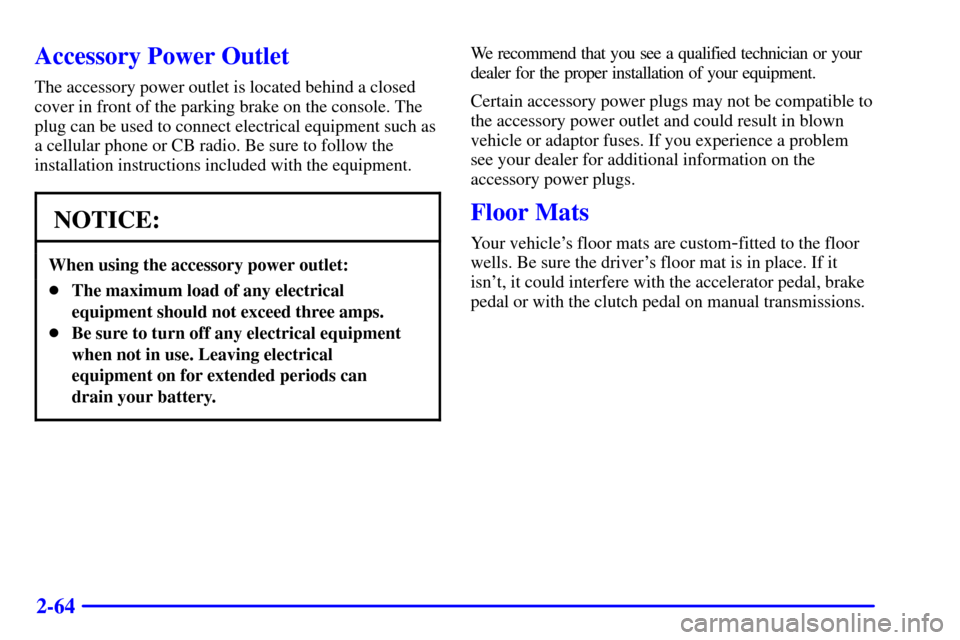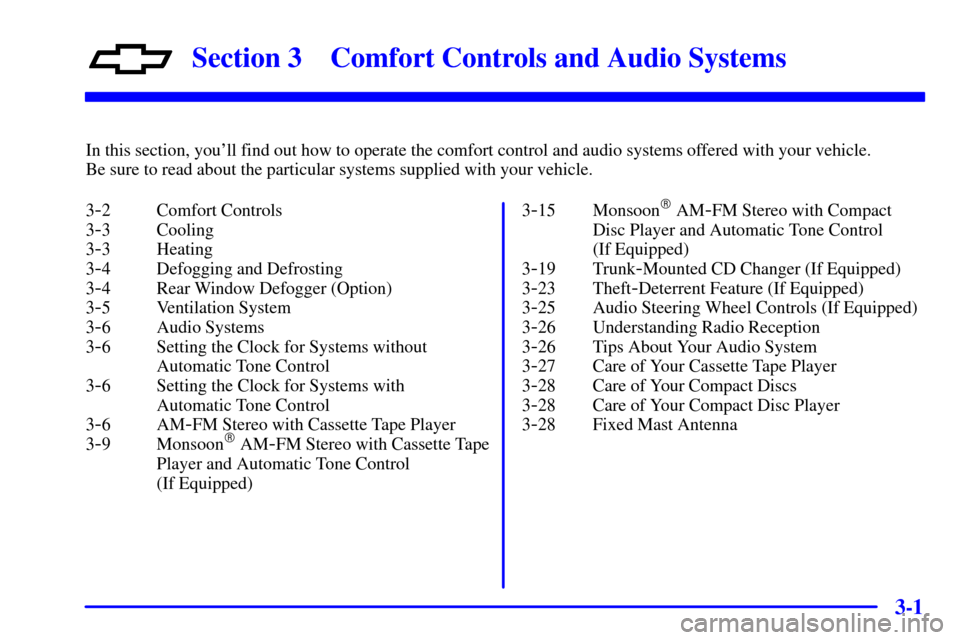Page 5 of 363
Table of Contents (cont'd)
Defensive Driving
Drunken Driving
Control of a Vehicle
Braking
SteeringDriving Tips for Various Road Conditions
Recreational Vehicle Towing
Loading Your Vehicle
Towing a Trailer Heating and Air Conditioning
Setting the Radio Clock
Radio/Cassette Player/CD PlayerRadio Theft-Deterrent Feature
Steering Wheel Controls (If Equipped)
Hazard Warning Flashers
Jump Starting
Towing Your VehicleEngine Overheating
Changing a Flat Tire
If You're Stuck
Problems on the Road
iii
Section
3
Section
4
Section
5
Comfort Controls and Audio Systems
Your Driving and the Road
Page 66 of 363

2-8 Lockout Prevention (If Equipped)
To protect you from locking your keys in the vehicle,
this feature stops the power door locks from locking
when the keys are in the ignition and a door is open.
If the power lock switch is pressed when a door is open,
a chime will sound five times as a reminder to take the
keys out of the ignition before locking the door.
The vehicle is shipped from the factory with this feature
turned on. If you would like to turn this feature off, see
ªFeature Customizationº in the Index.
Leaving Your Vehicle
If you are leaving the vehicle, take your keys, open your
door and set the locks from inside. Then get out and
close the door.
Keyless Entry System (Option)
If your vehicle has this feature, you can lock and unlock
your doors or unlock your trunk from about 3 feet (1 m)
up to 30 feet (9 m) away using the remote keyless entry
transmitter supplied with your vehicle.
Your keyless entry system operates on a radio frequency
subject to Federal Communications Commission (FCC)
Rules and with Industry Canada.
Page 69 of 363

2-11 Matching Transmitter(s) to Your Vehicle
Each remote keyless entry transmitter is coded to
prevent another transmitter from unlocking your vehicle.
If a transmitter is lost or stolen, a replacement can be
purchased through your dealer. Remember to bring any
remaining transmitters with you when you go to your
dealer. When the dealer matches the replacement
transmitter to your vehicle, any remaining transmitters
must also be matched. Once your dealer has coded the
new transmitter, the lost transmitter will not unlock your
vehicle. Each vehicle can have only four transmitters
matched to it.
Have each transmitter you intend to match ready for the
next steps. To match transmitters to your vehicle, do
the following:
1. Turn the ignition key to RUN, then to OFF.
This will disarm the content theft
-deterrent/alarm
system (option).
2. Remove the RADIO fuse. This fuse is located in the
main fuse block which is located on the left side of
your instrument panel. See ªFuses and Circuit
Breakersº in the Index.3. Turn the ignition key from OFF to RUN three times
quickly (within five seconds). The vehicle will respond
by locking the doors, unlocking the driver's door and
releasing the hatch. Your transmitter is now ready to
match the vehicle. Leave the ignition in RUN.
4. Press and hold the LOCK and UNLOCK buttons on
the first transmitter for 15 seconds. The vehicle will
respond as in Step 3.
5. Repeat Step 4 for the remaining transmitters.
6. When you have finished matching all of your
transmitters, replace the RADIO fuse.
7. Check that all transmitters work by pressing
the buttons.
If the transmitters don't work, or if you'd rather not
match the transmitters yourself, see your dealer.
Page 80 of 363

2-22 Entering Programming Mode
To program any feature, your vehicle must be in the
programming mode. Follow these steps:
1. Put your key in the ignition.
2. Turn the ignition to RUN to disarm the content
theft
-deterrent/alarm system.
3. Turn the ignition to OFF.
4. Remove the RADIO fuse. This fuse is in the
main fuse block, located on the left side of your
instrument panel. See ªFuses and Circuit Breakersº
in the Index.
5. Turn the ignition toward you to ACC.
6. Count the number of chimes you hear. You will hear
one or two chimes depending on the features your
vehicle is equipped with. Refer to the chart
shown previously.
You can now program your choices.
To exit the programming mode, follow the steps listed
under ªLeaving Programming Modeº later in
this section.
Exit Lighting and Delayed Illumination
With Exit Lighting, your interior lamps will come on for up
to 25 seconds when the key is removed from the ignition.
With Delayed Illumination, your interior lamps will come
on and stay on for up to 25 seconds when entering your
vehicle and up to five seconds when leaving your vehicle.
Programmable Modes
Mode 1: Both Off
Mode 2: Delayed Illumination Only
Mode 3: Exit Lighting Only
Mode 4: Both On
Page 86 of 363

2-28
When your vehicle was shipped from the factory, it was
programmed in Mode 4. The mode to which the vehicle
has been programmed may have been changed since it
left the factory. To determine the mode to which your
vehicle is programmed or to program your vehicle to a
different mode, do the following:
1. Turn the parking lamps on and off.
2. Count the number of chimes you hear. The number
of chimes tells you which mode your vehicle is set
for. (If you do not wish to change the current mode,
you can either exit the programming mode by
following the instructions later in this section or
program the next feature available on your vehicle.)
3. Turn the parking lamps on and off again until you
hear the number of chimes that corresponds to the
mode selection you want.
The mode you selected is now set. You can either exit
the programming mode by following the instructions
later in this section or program the next feature available
on your vehicle.
Exiting Programming Mode
When programming is complete, turn the ignition to
OFF and reinstall the RADIO fuse.
New Vehicle ªBreak-Inº
NOTICE:
Your vehicle doesn't need an elaborate
ªbreak
-in.º But it will perform better in the
long run if you follow these guidelines:
�Keep your speed at 55 mph (88 km/h) or
less for the first 500 miles (805 km).
�Don't drive at any one speed
-- fast or
slow
-- for the first 500 miles (805 km).
Don't make full
-throttle starts.
�Avoid making hard stops for the first
200 miles (322 km) or so. During this time
your new brake linings aren't yet broken
in. Hard stops with new linings can mean
premature wear and earlier replacement.
Follow this breaking
-in guideline every
time you get new brake linings.
�Don't tow a trailer during break
-in.
See ªTowing a Trailerº in the Index for
more information.
Page 88 of 363

2-30
OFF (C): This position unlocks the steering wheel,
ignition and automatic transmission, but does not send
electrical power to any accessories. Use this position if
your vehicle must be pushed or towed. A warning tone
will sound if you open the driver's door when the
ignition is in OFF and the key is in the ignition.
RUN (D): This is the position the switch returns to after
you start your engine and release the switch. The switch
stays in RUN when the engine is running. But even
when the engine is not running, you can use RUN to
operate your electrical power accessories and to display
some instrument panel warning and indicator lights.
START (E): This position starts the engine. When the
engine starts, release the key. The ignition will return to
RUN for normal driving.
Even if the engine is not running, ACC or RUN or
Retained Accessory Power (RAP), when active, allow
you to operate your electrical accessories, such as the
radio and ventilation fan. See ªRetained Accessory
Power (RAP)º in the Index.Key Release Button (If Equipped)
If you have a manual
transmission, your
ignition lock has a key
release button.
You must press the key release button to turn the
ignition key to LOCK before you can take your key out.
Page 122 of 363

2-64
Accessory Power Outlet
The accessory power outlet is located behind a closed
cover in front of the parking brake on the console. The
plug can be used to connect electrical equipment such as
a cellular phone or CB radio. Be sure to follow the
installation instructions included with the equipment.
NOTICE:
When using the accessory power outlet:
�The maximum load of any electrical
equipment should not exceed three amps.
�Be sure to turn off any electrical equipment
when not in use. Leaving electrical
equipment on for extended periods can
drain your battery.
We recommend that you see a qualified technician or your
dealer for the proper installation of your equipment.
Certain accessory power plugs may not be compatible to
the accessory power outlet and could result in blown
vehicle or adaptor fuses. If you experience a problem
see your dealer for additional information on the
accessory power plugs.
Floor Mats
Your vehicle's floor mats are custom-fitted to the floor
wells. Be sure the driver's floor mat is in place. If it
isn't, it could interfere with the accelerator pedal, brake
pedal or with the clutch pedal on manual transmissions.
Page 155 of 363

3-
3-1
Section 3 Comfort Controls and Audio Systems
In this section, you'll find out how to operate the comfort control and audio systems offered with your vehicle.
Be sure to read about the particular systems supplied with your vehicle.
3
-2 Comfort Controls
3
-3 Cooling
3
-3 Heating
3
-4 Defogging and Defrosting
3
-4 Rear Window Defogger (Option)
3
-5 Ventilation System
3
-6 Audio Systems
3
-6 Setting the Clock for Systems without
Automatic Tone Control
3
-6 Setting the Clock for Systems with
Automatic Tone Control
3
-6AM-FM Stereo with Cassette Tape Player
3
-9 Monsoon� AM-FM Stereo with Cassette Tape
Player and Automatic Tone Control
(If Equipped)3
-15 Monsoon� AM-FM Stereo with Compact
Disc Player and Automatic Tone Control
(If Equipped)
3
-19 Trunk-Mounted CD Changer (If Equipped)
3
-23 Theft-Deterrent Feature (If Equipped)
3
-25 Audio Steering Wheel Controls (If Equipped)
3
-26 Understanding Radio Reception
3
-26 Tips About Your Audio System
3
-27 Care of Your Cassette Tape Player
3
-28 Care of Your Compact Discs
3
-28 Care of Your Compact Disc Player
3
-28 Fixed Mast Antenna